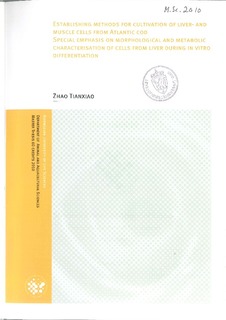| dc.description.abstract | Atlantic cod is regarded as one of the most promising future aquaculture species in Norway. However, the cod aquaculture industry is facing major problems with occurrence of “fatty livers” leading to high degree of tissue offal at slaughter. Only a small extent can be utilized in fish oil production. One of the aims of this thesis was therefore to establish a cod liver cell culture model enabling detailed studies of how nutritional factors may influence liver growth and fat deposition. It is further a goal for the industry to optimize the cod’s utilization of energy from the diet for muscle growth and to less extent for deposition of fat in the liver. We therefore also wanted to establish a muscle cell culture model enabling future studies of how nutrients affect cod muscle- growth and metabolism. In vitro culture of unspecialised precursor cells from liver show that these cells possess high proliferation capacity. Hormones or lipids were added in order to study the effects on cell development (differentiation). The expression of several genes were analysed at different stages during the cell differentiation process. Our results show that liver cells at confluence, given a lipid mixture or a differentiation mixture containing hormones, went through significant morphological changes with time. Cells cultivated in a media with lipid supplementation showed a significant increase in the gene expression of PPAR. We also tested some genes known to be highly expressed at late differentiation stages. Although no significant effects, all the genes GPDH, FABP-6, GLUT4, Annexin2, and Annexin3 showed tendencies to increasing expression with time during the differentiation process. We also succeeded in isolating and differentiating cod muscle cells. Q-PCR results from two stages of differentiating muscle cells showed that the expression of the early muscle specific marker MyoD decreased and the late marker α-actinin gene increased significantly from day 2 to day 9, verifying, together with morphology data that these cells develop from un-mature muscle cells to more mature multinucleated myotubes with time. The lipid class distribution of liver cells at confluence showed that the cells at this stage had approximately equal distribution of TAGs (24.0%), phospholipids (22.5%) and CE (21.4%) and lower levels of DAG (16.6%), FFA (10.4%) and MAG (5.2%). The cells at confluence had high capacity for uptake of palmitic acid (PA), in agreement with high degree of immunostaining of the fatty acid transporter FATP1. Approximately 88% of radioactivity from 1-14C-PA taken up into the cells was found in phospholipids. We also found that the radioactive PA was to a major extent (90%) elongated and desaturated to 18:1n-9 (oleic acid) and only 10% remained as 16:0. | no_NO |
